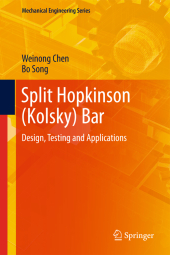 Neuerscheinungen 2012Stand: 2020-01-07 |
Schnellsuche
ISBN/Stichwort/Autor
|
Herderstraße 10
10625 Berlin
Tel.: 030 315 714 16
Fax 030 315 714 14
info@buchspektrum.de |

Weinong W. Chen, Bo Song
(Beteiligte)
Split Hopkinson (Kolsky) Bar
Design, Testing and Applications
2012. ix, 388 S. 170 SW-Abb. 235 mm
Verlag/Jahr: SPRINGER, BERLIN 2012
ISBN: 1-461-42760-6 (1461427606)
Neue ISBN: 978-1-461-42760-5 (9781461427605)
Preis und Lieferzeit: Bitte klicken
This book details the general principles of Kolsky bars, or split Hopkinson bars, used for obtaining dynamic material properties. It assists both beginners and professionals in characterizing high-rate material response with high quality and consistency.
The authors systematically describe the general principles of Kolsky bars, or split Hopkinson bars, which are widely used for obtaining dynamic material properties. Modifications are introduced for obtaining reliable data. Specific experiment design guidelines are provided to subject the specimen to desired testing conditions.
Detailed Kolsky-bar examples are given for different classes of materials (brittle, ductile, soft, etc) and for different loading conditions (tension, torsion, triaxial, high/low temperatures, intermediate strain rate, etc). The Kolsky bars used for dynamic structural characterization are briefly introduced. A collection of dynamic properties of various materials under various testing conditions is included which may serve as a reference database.
This book assists both beginners and experienced professionals in characterizing high-rate material response with high quality and consistency. Readers who may benefit from this work include university students, instructors, R & D professionals, and scholars/engineers in solid mechanics, aerospace, civil and mechanical engineering, as well as materials science and engineering.
Conventional Kolsky bars.- Kolsky compression bar experiments on brittle materials.- Kolsky compression bar experiments on soft materials.- Kolsky compression bar experiments on ductile materials.- Multiaxial compression experiments.- Experiments at high/low temperatures.- Tensile experiments.- Torsional experiments.- Kolsky bars for intermediate-rate experiments.- Structural experiments.


